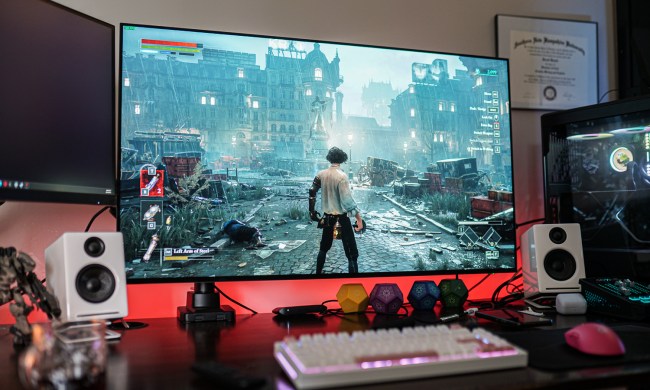- Excellent cable management and design
- Minimal bloatware
- Lifetime 24/7 support
- Great CPU, GPU, and motherboard options
- Easy to upgrade
- Expensive
- Few non-Corsair part options
- Limited front panel ports
Why buy a desktop PC when you can build one yourself for less? That’s a question Origin PC, which was acquired by Corsair a couple of years ago and specializes in prebuilt PCs, has been trying to answer for years. But now, with GPU prices where they’re at, buying a prebuilt desktop has never made more sense.
Even though Origin’s prebuilt desktops include many off-the-shelf parts, they’re more than just a few components hastily slapped together.
The Origin Neuron showcases that. It’s the mid-tower option from Origin’s range, serving as a middle ground between the extended tower Genesis and the small form factor Chronos. Like all Origin desktops, you can outfit the Neuron with parts you want, including the most recent graphics card from AMD and Nvidia.
Given how expensive graphics cards are right now, the Neuron is a solid alternative to building your own gaming PC. If you don’t want a massive tower taking up too much room or a small form factor machine that could be prone to noise issues, the Neuron is the perfect option. And in 2021, most midrange configurations aren’t much more expensive than building a gaming rig yourself.
Design
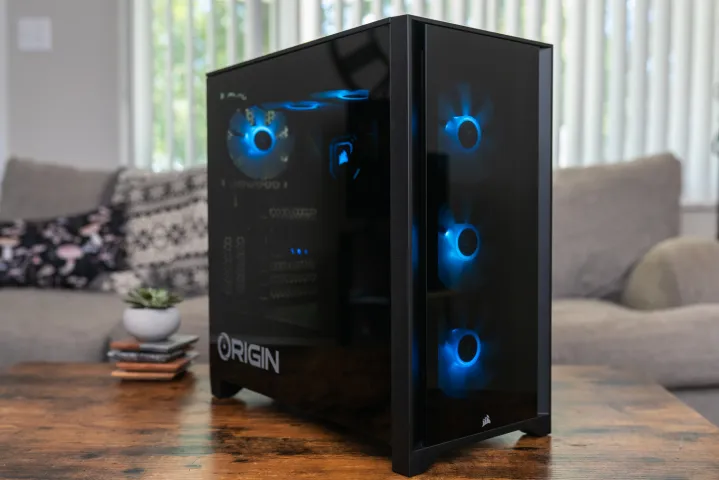
The Origin Neuron is built with off-the-shelf parts — assuming you can find a graphics card, you can put together an exact match. Because of that, it doesn’t feature some of the comforts of something like the HP Omen 30L with its tool-less design. You’ll still need to unscrew things and have a tray handy for parts if you want to get inside.
Still, the Corsair 4000X case makes upgrades feel effortless. The side panels each come with latches toward the front, which make it easy to slot them back in place, and the thumbscrews are captive. They even have a small yellow ring around them, which makes them easy to spot when taking off the side panel.
It’s worth noting that the Corsair 4000X is only one of the case options. It features a tempered-glass side panel, which stays on the side of the case even with the thumbscrews out. To get it off, there’s a convenient lever, which allowed me to take off the side panel without smudging it with fingerprints.
Although you can put together the individual parts of the Origin Neuron yourself, you might not be able to so with the same tidiness. The machine is remarkably well-built, with clean cable runs on the back of the case and only minimal overhang in the front. That’s a testament to Origin’s building prowess, as is the large, open space that the Corsair 4000X provides.

You have plenty of room for upgrades, too. With all off-the-shelf parts, you can swap out anything in the case down the line. The Corsair 4000X comes with two SSD trays and two hard drive trays, giving you plenty of room for storage. As for M.2 support, it’s going to depend on the motherboard you choose.
Once everything was set up, I took a look through the preinstalled software. There were a few programs, most of which you’ll use. You have access to an overclocking utility for the graphics card, Corsair iCUE, and an audio settings app. I would have preferred MSI Afterburner for the overclocking tool because it’s the de-facto option for many enthusiasts (including myself). Still, these programs are useful and don’t bloat the machine out of the box.
Connectivity
The ports you get on the Neuron will depend on the configuration you choose. Each case and motherboard has a different combination. For the build Origin sent me, I was spoiled for options in terms of connectivity, but sadly only around the back of the chassis.
Up front, the Corsair 4000X has a pitiful selection. You have one USB 3.0 port, one USB-C 3.1 port, and a headphone/microphone combo jack. That’s it. Although I loved seeing USB-C in the front, Corsair could have squeezed an extra USB port or two on the front panel. The 4000X has a clean design without too many exposed ports, but a couple of extra USB connections wouldn’t have hurt that.
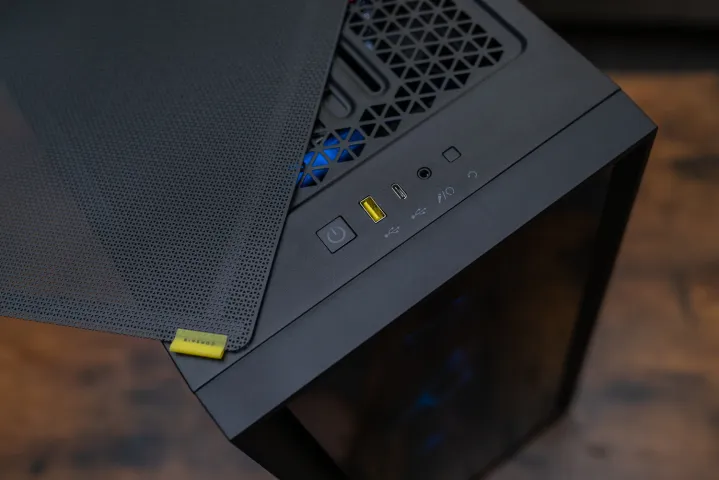
My review unit came with an Asus ROG Crosshair VIII Hero motherboard, which isn’t available on Origin’s website at the time of publication. This board comes with an absurd amount of ports. It includes Gigabit and 2.5Gbit LAN, USB-C 3.2, and 10 USB 3.2 ports. If you need a lot of USB devices, this board has you covered.
Although you can’t buy the board in my unit right now — at least through Origin — there are plenty of other options available. At the time of publication, I found an MSI MEG X570 Ace board, which fits in the same class as the Crosshair board. Unfortunately, it doesn’t come with as many USB ports, so go for the Crosshair if it’s available and you want a high-end motherboard.
Every case comes with two USB ports up front — either both USB-A or a combination with USB-C. An SD card reader would have been nice, too, though most off-the-shelf cases don’t include one.
Internals
My review unit was kitted out with the latest parts from AMD and Nvidia, including the 16-core Ryzen 9 5950X and 12GB RTX 3080 Ti respectively. Although this is about as high-end as gaming desktops go, the Neuron can accommodate even more. Origin offers up to a 64-core Ryzen Threadripper 3990X (though, not the Pro model like the Lenovo P620 offers).
| CPU | AMD Ryzen 9 5950X |
| GPU | Nvidia RTX 3080 Ti |
| Motherboard | Asus ROG Crosshair VIII Hero Wi-Fi |
| Case | Corsair 4000X |
| Memory | Corsair Vengeance RGB Pro 32GB 3,200MHz (2 x 16GB) |
| Storage | Corsair MP600 1TB, Samsung 870 QVO 2TB |
| Power supply | Corsair RM850X 80+ Gold |
| USB ports | 11 USB-A, two USB-C |
| Networking | 2.5Gbit, 1Gbit Ethernet |
The standard configuration runs about $2,400. For that price, you’re getting a Core i7-10700K, 16GB of memory, and an RTX 3060 Ti. Although this is the “starting price,” you can actually save some money by configuring the machine yourself. By swapping in a Ryzen 5 5600X and RX 6700 XT, I was able to get the Neuron down to $2,100 using the configurator.
As for my review unit, it clocks in at just over $5,100, and that’s a midrange configuration. Kitted out with the best of the best, you can easily spend over $10,000 on the Neuron. If that sounds like a lot, it’s because the Neuron is much more expensive than the competition.
I configured an almost identical Maingear Vybe for $5,051, and a similar Falcon Northwest Talon configuration clocked in at $5,352. For custom, the Neuron is where it should be. Pre-builts are a different story. The HP Omen 30L, with slightly lower specs, comes in around $2,500. Meanwhile, the preconfigured Maingear Vybe with an RTX 3080 Ti is $3,500.
The prebuilt Vybe is the most interesting comparison. It’s almost identical to the Neuron Origin sent me, just with a Ryzen 9 5900X processor. Origin offers a prebuilt version of the Neuron, but it’s limited to one configuration. At HP and Maingear, you have access to a range of options, all of which are less than customizing your own rig.
This is a top-spec machine with some of the highest-quality components inside.
Still, it’s hard to arrive at a bad configuration given the options the Neuron provides. Outside of the motherboard, graphics card, and processor, you have access to Corsair parts, and Corsair makes great RAM, power supplies, and AIO coolers. Although the vertical integration may rub some people the wrong way, I can’t complain. This is a top-spec machine with some of the highest-quality components inside.
You mostly have access to Corsair drives, too, though Origin also offers a few Samsung options. Samsung drives are some of the best, so I was happy to see them.
Still, I have a few issues with the building options. For one, there aren’t any options for air cooling. You can only select an AIO, and only one is available from Corsair. In addition, RGB case fans are obscenely expensive given that you only have access to Corsair options. They’re some of the best PC case fans around, but they have a price to match.
And price is the main issue. I parted out the base machine using currently available prices (with MSRP for the graphics card) and came out at $1,430. That’s nearly $1,000 premium to Origin for some extra branding and putting everything together it’s $2,400 standard configuration. Given the prices of graphics cards right now, however, the Neuron isn’t a bad deal. Accounting for inflated prices, building this machine yourself would be close to $2,000.
Processor performance
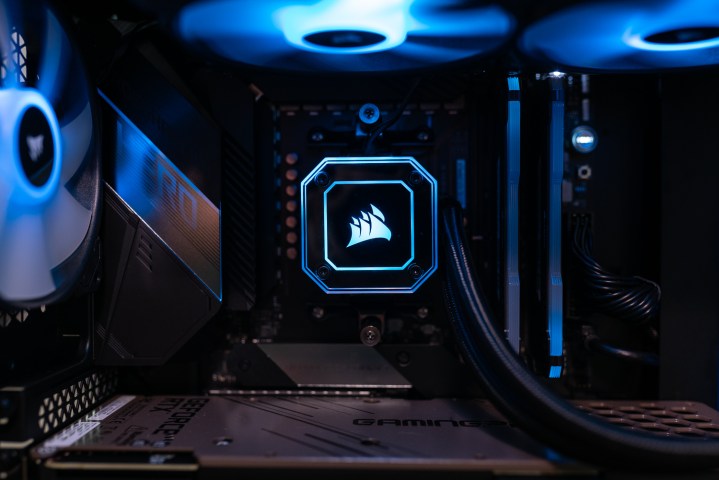
Processor performance is going to come down to how you configure the Neuron. If you choose to go with the Ryzen 9 5950X like my review unit had, you’re in luck. There’s nothing quite as powerful on consumer desktops, outside of AMD’s own Threadripper chips.
The 16 cores and 32 threads went to work quickly in Cinebench R23. Cinebench uses the processor to render an image instead of the graphics card, measuring both single- and multi-core performance. It reached a score of 25,116 in the multi-score, which is faster than any desktop CPU you can buy outside of Threadripper.
Outside of workstation-class parts, there isn’t another processor as powerful as the Ryzen 9 5950X.
For reference, Intel’s 10-core i9-10900K reached a score of about 15,000. Single-core performance matched the other processors in the Ryzen 5000 range, including the one inside the Falcon Northwest Talon.
Geekbench 5 provides more grounded performance, but even then, the Ryzen 9 5950X outclassed the Core i9-10900K by around 30%. This test showed some favor to single-core performance, too. My sample chip showed a modest improvement of about 6% over the CyberPower Xtreme rocking the Ryzen 7 5800X.
The Ryzen 5950X showed how close it can get to Threadripper chips in the content-creation benchmarks. In PugetBench for Premiere Pro, it managed an overall score of 1,088. That’s about 18% off the Threadripper 3995WX, which runs close to $5,500. Outside of workstation-class parts, there isn’t another processor as powerful as the Ryzen 9 5950X.
In Handbrake, the Ryzen 9 5950X actually met the Threadripper 3995WX, with only one second separating the render times. Intel’s Core i9-10900K didn’t fare as well, sitting about 35% below the Ryzen 9 5950X in my Handbrake test.
Gaming performance
For the machine Origin sent me, 4K is the target. The RTX 3080 Ti can blow past 1080p and 1440p in most games, achieving frame rates well about 100 frames per second (fps). You don’t need to look further than Red Dead Redemption 2 to see that, where the Neuron earned a 110 fps average at 1440p Ultra settings.
The RTX 3080 Ti aims for 4K, but it doesn’t always get there. Maxed out at 4K, I managed 55 fps in Assassin’s Creed Valhalla. This is a very punishing title, and the RTX 3080 Ti is on the high end of performers. Still, it only showed a slight improvement over the RTX 3080 inside the HP Omen 30L. As far as the Falcon Northwest Talon with an RTX 3080, it scored identically.
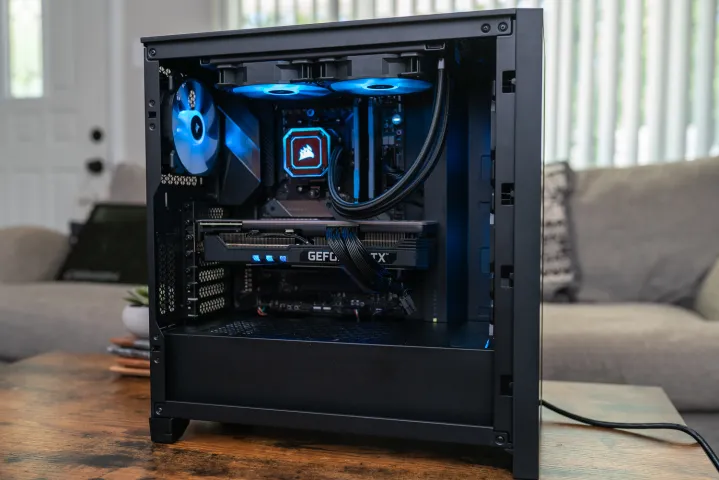
Red Dead Redemption 2 fared much better with a 72 fps average at 4K Ultra. Fortnite was no match for the RTX 3080 Ti, either, as it scored above the RTX 3080 at 89 fps with all of the sliders turned up. Assassin’s Creed Valhalla and Red Dead Redemption 2 are two of the most demanding games on PC, and the RTX 3080 Ti can still keep up with them.
The RTX 3080 can keep up, too. Even in the most demanding situations, only a few frames separate it and the Ti model at 4K. Keep in mind that the RTX 3080 Ti is a $718 upcharge over the RTX 3080 in the Neuron. That extra price barely buys you any more performance at 4K.
That’s true even in synthetic benchmarks. Comparing my 3DMark Time Spy result to the average of RTX 3080 results with the same configuration, there’s only about a 5% difference. For reference, the RTX 3070 Ti is only about 10% slower than the RTX 3080 Ti in this test while being $1,000 less at Origin.
Ray tracing is a big feature of the RTX 30-series, so I turned to Control for ray tracing performance. To my surprise, the RTX 3080 Ti managed 35 fps at 4K with ray tracing turned to High. That’s about a 44% performance penalty for having ray tracing on, but you can always use Nvidia’s Deep Learning Super Sampling (DLSS) to boost frame rates.
The RTX 3080 Ti is a 4K gaming monster, but that shouldn’t surprise anyone. It better be for the price Origin is charging. What surprised me is just how close it is to the RTX 3080, which is significantly cheaper. The non-Ti model is slower, but when over $700 is on the line, a few extra frames are hard to justify.
Warranty and support
A big reason to go prebuilt is support. After all, there aren’t any warranties for messing up a build yourself (even if the chances are low with the right instruction). Origin, along with basically all other custom PC builders, doesn’t do well in this regard. For the Neuron, you’re looking at a one-year standard warranty for part replacement, with free shipping only available for the first 45 days.
The Neuron ships in a wooden crate, so no free shipping past 45 days is a big deal. One year is the standard for most PC builders, including Maingear, Falcon Northwest, and CyberPowerPC. I would have liked to see free shipping for the warranty period, though. That upgrade alone costs $70 at Origin.
It isn’t all bad news for support, though. After your purchase, Origin offers 24/7 lifetime support, as well as free lifetime labor if you want to upgrade your PC down the line.
Our take
Like most custom-built PCs, the Origin Neuron charges a premium for convenience. That premium isn’t as big in 2021 as it has been in previous years, however. Keeping in mind the price of an RTX 3080 Ti right now, you could build the exact machine Origin sent me for around $1,400 as opposed to $2,400. That extra $1,000 gets you the build, some extra goodies, and a part replacement warranty.
As someone who enjoys putting together PCs, I will always choose to save money and part out a system myself. However, the price difference at Origin isn’t that big, especially on lower-spec machines. As my testing shows, you can get most of the performance of an RTX 3080 Ti out of the RTX 3080, too, and that difference alone brings the price scales back in balance.
Overall, the Origin Neuron is an expertly built machine that earns its asking price in a sea of machines that don’t. DIY is always cheaper, though, and the 2021 Neuron doesn’t change that.
Are there any alternatives?
Yes. The Maingear Vybe and Falcon Northwest Talon are custom alternatives, and the HP Omen 30L and prebuilt Maingear Vybe are cheaper options that you can’t configure. Origin stands out with build quality, including clean cable management and minimal bloatware. However, all of the components are available separately, and you’ll save big if you piece them together yourself.
How long will it last?
The Origin Neuron will last as long as you want it to. It uses standardized parts, so you can continue upgrading and expanding it for as long as the ATX standard is upheld. The base model will hold up at 1080p and 1440p for several years before you need to upgrade.
Should you buy it?
A $1,000 building fee is tough to swallow when you can build an exact match yourself, but for those not wanting to build their own, the Neuron is an excellent premium option.






